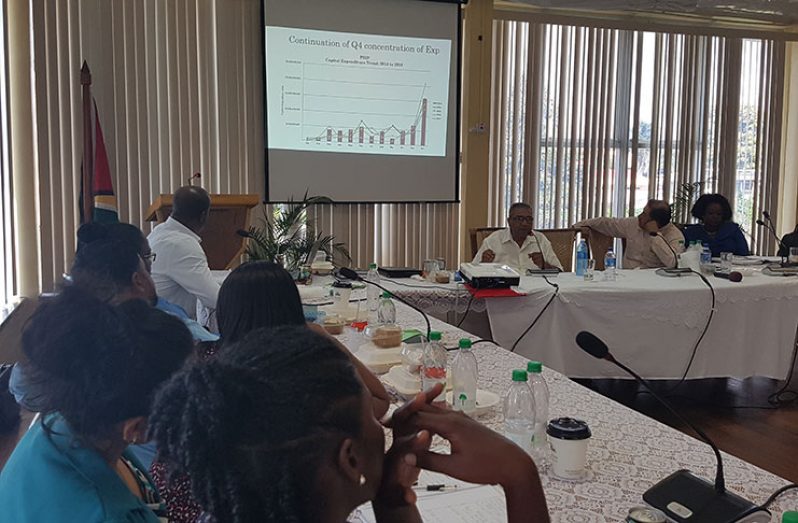–to help Indigenous Peoples’ Affairs Ministry to deliver budget expectations
THE Ministry of Indigenous Peoples’ Affairs is well positioned to deliver its 2019 budget with emphasis on the implementation of a “five-star” approach for projects and other forms of public spending this year.
According to a release from the ministry, on Wednesday the Ministry of Finance handed over a blueprint to the Ministry of Indigenous Peoples’ Affairs when the latter hosted a conference with senior management functionaries at the Resource Centre on Woolford Avenue, Georgetown.
Discussions centred on the delivery of the Public Sector Improvement Programme (PSIP) since it will ultimately determine public spending.
Tarachand Balgobin, Director of the Project Cycle Management Division at the Ministry of Finance, emphasised the need for a pro-active plan, pointing to a five-star government-proposed approach which, with proper implementation, will ensure budgetary allocations for the respective ministries are maximised.
He said the first of the five approaches, deemed ‘The Quick Gains’ approach, will see a matrix developed for all roll-over projects with stipulated timelines and progress reports, and once those timelines and guidelines are observed, implementation of project/s will be executed in accordance with government’s developmental agenda.
This approach will identify issues, challenges and concerns which were encountered during the execution phase.
‘The Green Dot’ approach, the second recommended approach, will see projects budgeted for in 2019 executed in a timely manner, since they would have been in a state of readiness following the acquisition of designs and bill of quantities.
Here again, a matrix must be developed which must include critical logistics information.
YELLOW DOT
The third phase or ‘The Yellow Dot’ approach focuses on projects for which no designs are available and hence cannot be tendered. Here, critical logistics information is also necessary. The fourth in the ‘five-star’ approach is the ‘Low Hanging Fruits’, which refers to the procurement of goods and services. This approach will also see several guidelines observed, among them, acquiring technical specifications, the commencement of the tendering process, and as far as practicable, group procurement of similar goods, equipment and supplies across departments/divisions, before proceeding to the ‘Green Dot’ phase.
The fifth and final approach is the ‘REDDD Flags’; a phase in which projects will be singled out for attention. These include miscellaneous roads, drains, bridges, schools, health facilities, and police stations to name a few. Balgobin, a 40-year veteran in the public sector, emphasised that “this exercise requires a FAN out by PCMD (Project Cycle Management Division) to assist with the speedy identification of prioritised projects and to assist the agencies to develop an aggressive procurement plan to move from REDDD to Yellow to Green”.
“This is in preparation for all the development that’s coming because in a couple years’ time, there is going to be an inflow of money into government’s coffers that will drive the demand for goods and services in the private sector. There will be more roads, more schools, more facilities and your ministry will be participating in that,” he said.
MAXIMISE SPENDING
Balgobin categorically noted that the public sector is the main driver for the private sector, and as such, it is fundamental that government ministries and public agencies maximise their spending ability based on budgetary allocations.
A paradigm shift is expected to take place in Guyana’s economy when American oil giant Exxon Mobil commences oil production in March 2020. The government is cognisant of this and is putting the necessary mechanisms in place to ensure spending is up to its maximum, the ministry said.
A sum of $1.9B has been budgeted for the Indigenous Peoples’ Affairs Ministry in 2019 for major improvements in the hinterland in the areas of education, primary and secondary health care and welfare support, entrepreneurship, water resource management, leadership and governance, land dispute resolution, extension and demarcation and cultural preservation.
The ministry said this is all in keeping with a 10-point plan laid out by President David Granger during the caucus of the National Toshaos Council in 2015. The ministry said it is well on track to deliver to the indigenous peoples its mandate, with approximately 95 per cent expended for both capital and current expenditure in 2018.



.jpg)








